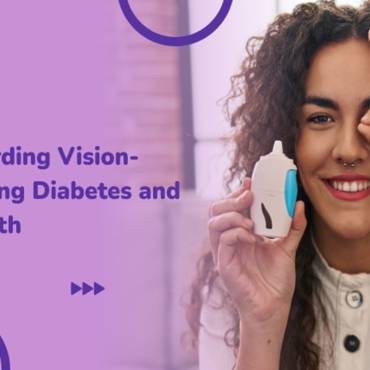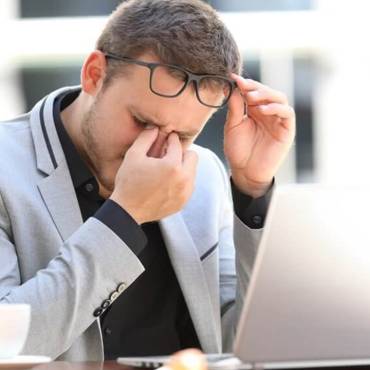More than 4.2 million people in the US aged 40 years and older are either legally blind or with low vision. The leading cases of blindness and low vision in the US are age-related eye diseases such as age-related macular degeneration, cataract, glaucoma, and retinopathy. Other common types of eyesight problems include strabismus and amblyopia.
Let’s briefly look at the top 10 common types of eye problems.
Age-Related Macular Degeneration
Macular degeneration, also called age-related macular degeneration, is an eye disease associated with aging and results in damaging central vision (a vision that is needed for seeing objects clearly and for common daily tasks such as driving and reading). It affects the macula, the central part of the retina that allows the eyes to see even the fine details. There are two forms of macular degeneration, namely wet and dry.
Wet age-related macular degeneration – Wet AMD develops when abnormal blood vessels behind the retina begin to grow under the macula, ultimately causing blood and fluid leakage. Bleeding and scarring from these blood vessels lead to damage and rapid central vision loss.
Dry age-related degeneration– Dry age-related macular degeneration or AMD occurs when the macula thins over time as part of the aging process, gradually blurring central vision. The dry form of macular degeneration is more common and progresses more slowly than the wet form. In such a case, central vision is gradually lost in the affected eye. The dry form generally affects both eyes. One of the most common early signs of the dry form of macular degeneration is drusen (tiny yellow or white deposits under the retina. Drusen are often found in people aged 60 years and older. Numerous drusen increase the risk of developing advanced dry and wet age-related macular degeneration.
Refractive Eye Conditions
Refractive eye conditions include myopia (nearsightedness), hyperopia (farsightedness), presbyopia, and astigmatism (distorted vision at all distances), which is the most frequent eye problem in the United States. These errors can be corrected by eye lenses, eyeglasses, or surgery. According to eye experts, the proper refractive correction could improve vision.
Cataract
A cataract is a clouding of the lens in the eye that affects vision. Most cataracts are related to aging; they are very common in older people. Although treatment for removing cataracts is widely available, a lack of awareness prevents many people from receiving the proper treatment.
Glaucoma
Glaucoma is an ophthalmic neurodegenerative condition characterized by raised intraocular pressure. Patients may experience visual field loss and even lose their vision completely if left untreated. Glaucoma is the second leading cause of eyesight loss globally. With early treatment, one can often protect your eyes against serious vision loss. There are two major types of glaucoma. Open-angle glaucoma is a chronic condition that progresses slowly over time without the person noticing vision loss until the eye condition is at an advanced stage. Angle-closure develops suddenly and is painful. Eyesight loss can progress quickly; however, the pain and discomfort cause patients to seek medical help before permanent damage occurs.
Diabetic Retinopathy
Diabetic retinopathy is one of the most common complications associated with diabetes. It is the major cause of vision loss in adults in the US. The eye condition is characterized by progressive damage to the retina’s blood vessels, the light-sensitive tissue at the back of the eye that is essential for healthy vision. Diabetic retinopathy usually affects both eyes. The risk of this eye condition is reduced through proper disease management that includes adequate control of blood pressure, blood sugar, and lipid abnormalities. Timely diagnosis reduces the risk of vision loss. However, as per CDC (centre for disease control and prevention), as many as 50% of patients are not getting their eyes tested or are diagnosed too late for therapy to be successful. Eye retina problem solutions include laser treatment that treats the growth of new blood vessels at the back of the eye (retina). Discuss with your ophthalmologist to get more brief information regarding the treatment.
Strabismus
Strabismus develops when the eyes are not lined up properly. It is commonly reported in children but can occur in adults. You may find that your child’s eyes point in different directions. You may also notice that your child closes one eye or tilts his/her head. This may help your kid’s eyes function together. There are different types of strabismus; the common ones include esotropia, hypertropia, and exotropia. Esotropia occurs when one or both eyes turn inward. Hypertropia is one eye turning position upward. Exotropia occurs when one or both eyes turn outward. In most cases, the causes are unknown.
Amblyopia
When the two eyes can’t focus on the same image, there is reduced or absent depth perception. The brain may learn to ignore the input from one eye, contributing to permanent loss of eyesight in that eye.
Dry Eye
Dry eye condition occurs when your tear glands cannot make enough tears or produce low-quality tears and can’t adequately lubricate the eye’s surface. Various treatment options are available, one of the most common being artificial tear or tear duct plugs that helps to prevent tear drainage.
Eye Tearing
This happens when your eyes can produce enough tears to be drained. The eye condition may develop due to sensitivity to climate elements like sun, wind, temperature changes, eye infection, or a blocked tear duct.
Eye Floaters
These are clumps deposits that float in your eye’s jelly-like substance in the middle of the eye. Floater develops as spots or specks that float in the field of vision. Mostly they are harmless and rarely could be a sign of a serious eye disorder such as retinal detachment.
How to Fix Eye Problems?
Well, eye care health experts perform eye examinations and carefully test every aspect concerned with the eyes. What may have the solution to your vision problems? Your eye care specialist will recommend treatment options appropriate for your eye condition that can work best to maintain your eye health. You can buy eye care products online to treat milder conditions like dry eyes and eye tearing.



